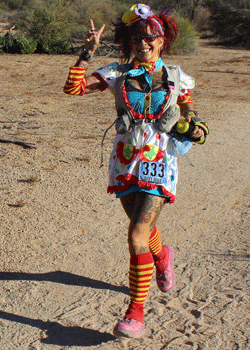Fall for 100s

Autumn is still a time for running far
By the end of September, the “biggies”—Western States, Bighorn, Leadville, Wasatch, The Bear, Tahoe Rim Trail—are in the books, but in the autumn you can still run a slew of quality 100-milers, from Florida to California, from New Hampshire to Washington State. While the summer high-mountain races garner the most headlines, fall races offer a low-key ambience, beautiful scenery, exploding colors, lower elevations and ease of entry, making them a fresh option for aspiring 100-milers.
“All of the training, miles and racing throughout the year build, and you are the most fit in the fall,” says Jeremy Duncan, 31, of Carbondale, Colorado, who attempted his first 100 this fall with Arizona’s Javelina Jundred. “You also get a bit of a boost from training in the heat all summer so when the weather breaks in the fall you have a slight edge in the cooler temps because your body doesn’t have to work as hard.”
A handful of races within the past two weeks exemplify the diversity and quality of fall options, including the Javelina Jundred in Fountain Hills, Arizona, Ghost Train Rail Trail Races in Milford, New Hampshire, Pinhoti in Sylacauga, Alabama, and Ozark Trail in Steelville, Missouri.
Run this year October 27-28, in McDowell Mountain Regional Park and debuted in 2003, the increasingly popular Javelina Jundred features a washing-machine loop format over rolling desert terrain (from 1800 to 2400 feet). Setting the tone of the low-key yet competitive event is its costumes-encouraged theme.
“Javelina is cool in that you switch directions every loop so it isn’t as boring. You also get to see everyone which is, for me, exciting and uplifting,” says Duncan. “You are always smiling at others and encouraging one another instead of being alone which can sometimes be tough mentally.
“With loop courses, mentally, it is easier to break down the task at hand into ‘one loop at a time.’ You also know what is coming after the first loop so you can plan when it’s best to slow down and step on the gas.”
One of the Granite State’s two ultras, the Halloween-inspired Ghost Train Rail Trail Races (October 27, 2012), offer ultra aspirants a relatively uncommitting trail and format, with the 100-mile event being “optional”—i.e. when you sign up for the ultra event, you may complete as many of the course’s 15-mile out-and-back (7.5 each way) jaunts as you wish, for ultra options of 30, 45, 60, 75, 90 and 100 miles (or more!). The railroad-grade-converted trail is “straight, flat and pretty well groomed” (according to the race website), and offers easy crew access and ample aid.
Dropping way down South, Pinhoti, which occurred November 3, offers a point-to-point format on beautiful trails in the Talladega National Forest, with 81 singletrack, 17 jeep-road and four paved miles. Run during the height of the fall colors, the rugged race features over 16,000 feet of climbing and tags the highest point in Alabama—Cheaha Mountain, at 2407 feet. This year’s geographically diverse field featured 108 finishers, topped by Neal Gorman of Charlottesville, Virginia, and followed by Jeremy Humphrey of McCall, Idaho, and Yassine Daboune of Portland, Oregon. The top three women, Denise Bourassa of Bend, Oregon, Megan Hall of Oak Harbor, Washington, and Melanie Fryar of San Antonio, Texas, came in back to back to back, taking fifth through seventh overall.
Says Pinhoti men’s race winner, Gorman, of autumn 100s, “Heat, humidity and altitude are not factors. And even if you’re not feeling as strong in the fall, the cooler weather and often-colorful scenery help make up for any loss in fitness.”
And of Pinhoti, specifically, he says, “In addition to the great course and colorful scenery of early November, the race is very well managed, from the aid stations, to the drop bags, to the course markings, to the pre-race meeting, to the post-race awards banquet. One word comes to mind: seamless. Plus, the fact that Pinhoti is now in the Montrail Ultra Cup makes the competition that much more stiff.”
In the hardwood forests of south-central Missouri, the mostly singletrack Ozark Trail 100-Mile Endurance Run in the Mark Twain National Forest offers another gorgeous point-to-point 100-miler, with nearly 15,000 feet of elevation gain. This year’s 54-percent finishing rate evidences the trail’s difficulty. Course records were set this year by Pierre Deragne of Lyon, France (18:33), and California’s Katie DeSplinter (25:10 and 10th overall).
Please go to www.trailrunnermag.com and peruse our Race Calendar to get your juices flowing.